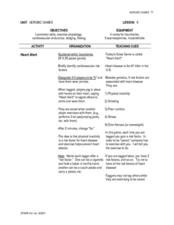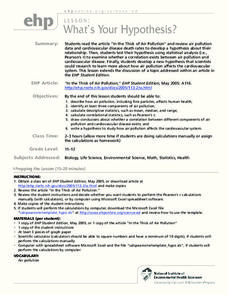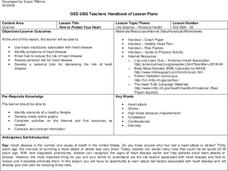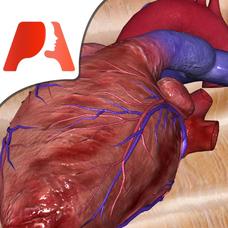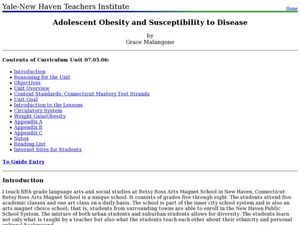Curated OER
Here's To Your Healthy Heart!
Learners examine the primary controllable and uncontrollable factors that put one at greater risk for developing heart disease. Through discussion, research, physical tests, and questionnaires they determine whether or not they are at...
Curated OER
Human Body Series - Cardiovascular System
Pump up your class while studying the cardiovascular system with this pair of activities. In one, learners record heart rates during different actions. In the second, they read kid-friendly heart health articles online and then write a...
National First Ladies' Library
Heart Health: Awareness and Research for Women
Students explore basic heart anatomy, review basic definition of heart disease, research different tests used to diagnose heart disease and heart attacks, discuss what constitutes a "healthy heart" lifestyle, and incorporate it into...
Curated OER
Cardiovascular Disease
In this health worksheet, students find the words that are related to cardiovascular disease and the answers are found at the bottom of the page.
Curated OER
Blood Pressure and Heart Disease
Young scholars explore the major causes of heat attacks as the topics of the human circulatory system, blood pressure, heart disease, arteries and veins are examined. Opinions on the topics are developed as researched material is...
Curated OER
Heart Disease Prevention
High schoolers create a PowerPoint presentation on heart disease. In this creative instructional activity students include symptoms, causes, treatments and ideas for prevention in their presentation.
Curated OER
Heart Alert
Explore some of the causes and preventions of heart disease. Young learners play a game of tag in which the taggers role play as risk factors for heart disease. Players who are tagged call out "heart alert" and are saved when someone...
Curated OER
What's Your Hypothesis?
Find the article, "In the Thick of Air Pollution," not through the resource link in the lesson, but through an Internet search. Have high schoolers read it and perform calculations with the statistics provided. The objective is to...
Curated OER
Cardiovascular Disease and Fitness: Exploring the Rhythm of Your Pulse
Learners explore several examples of cardiovascular diseases. In this anatomy lesson, students explain why physical fitness is very important. They count their pulse rate and record them on a data table.
Curated OER
How to Protect Your Heart
Students examine risk factors associated with heart disease and develop their own personal plans for decreasing the risk of heart disease.
Biology in Motion
The Cardiovascular System
When resting, blood goes from the heart to the lungs and back in about six seconds. An animation of the heart starts simply by showing blood flow through the two halves. It builds in complexity slowly over the course of five slides,...
Curated OER
Brushing Teeth Halts Heart Disease
Ninth graders examine the causes and effects of Heart Disease. In this ESL Current Events lesson, 9th graders read an article on Heart Disease. Students complete guided questions on the reading.
Curated OER
Healthy Heart Commitment Card
Make a commitment to give up one, just one, unhealthy food or drink. Teachers make a commitment for a month, the youngsters make a commitment for two weeks. The youngsters buddy up to support each other. Do this activity in February,...
Pocket Anatomy
Pocket Heart
An all-encompassing, fully interactive, gorgeously animated model of the heart can be used to teach cardiac anatomy, physiology, and even a touch of epidemiology.
Teach Engineering
Heart to Heart
Begin a unit on the heart, the parts and the function of the heart, and about heart disease with a resource that includes a lecture, a PowerPoint presentation, and research information. The lesson is the first of a four-part series...
Curated OER
A Healthy Heart is a Happy Heart
Students demonstrate their perception of what it means to have a healthy heart. They comprehend what each individual needs to do in order to ensure health and how to prevent heart disease.
Curated OER
Heart Disease & Stroke
Students study heart disease and how to prevent it. In this investigative lesson plan students list heart disease and stroke risk factors.
Curated OER
Heart 2: Changing Lifestyles and Heart Health
Young scholars examine and evaluate changes in diet and lifestyle from prehistoric to modern times and how these differences have spurred the development (and better treatment) of heart disease.
Curated OER
Health Concerns Lecture
This lesson on health concerns includes a ton of information. There is a PowerPoint presentation that walks through the entire lesson. If you want a quick introduction to these topics then run through this slide presentation quickly, but...
Curated OER
What Increases the Risk of Cardiovascular Disease?
Students analyze the risk factors for cardiovascular disease and classify them according to whether or not they are controllable. They discover how to reduce the probability of high blood pressure through diet and exercise.
Curated OER
Adolescent Obesity and Susceptibility to Disease
Students understand the importance of maintaining a healthy weight and good health. In this health lesson students read text then create their own pamphlet on the cardiovascular system, weight gain, treatments and health risks.
Curated OER
Heart Disease Prevention
Fourth graders get into groups and brainstorm ways to obtain physical activity and different healthy foods to eat. They then develop and write and individual plan for healthy living and commit to enforcing their plan for a minimum of one...
Curated OER
Crime Scene Investigation - Biology Teaching Thesis
Students explore the different blood types, and are introduced to new knowledge through a crime scene simulated activity. They explore the genetics of blood types, and are introduced to immunology/diseases.
Curated OER
The Heart Stopper
Use the pump from a spray bottle to drive a model of the heart in action! In addition to modeling the function of the heart and blood vessels, aspiring anatomists also simulate arterial blockage. They compare the effects of increased...








